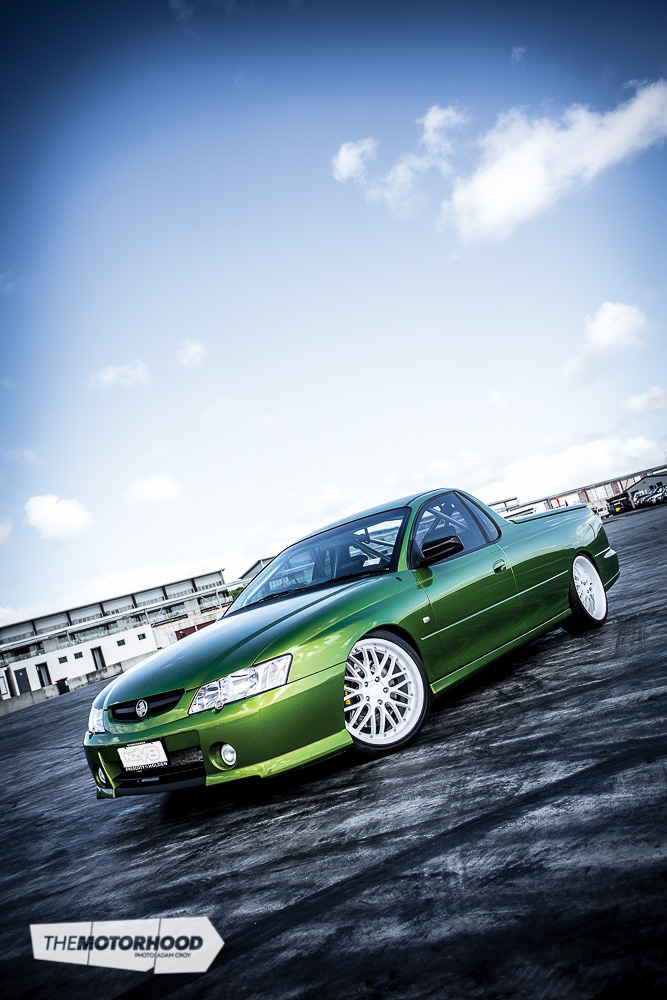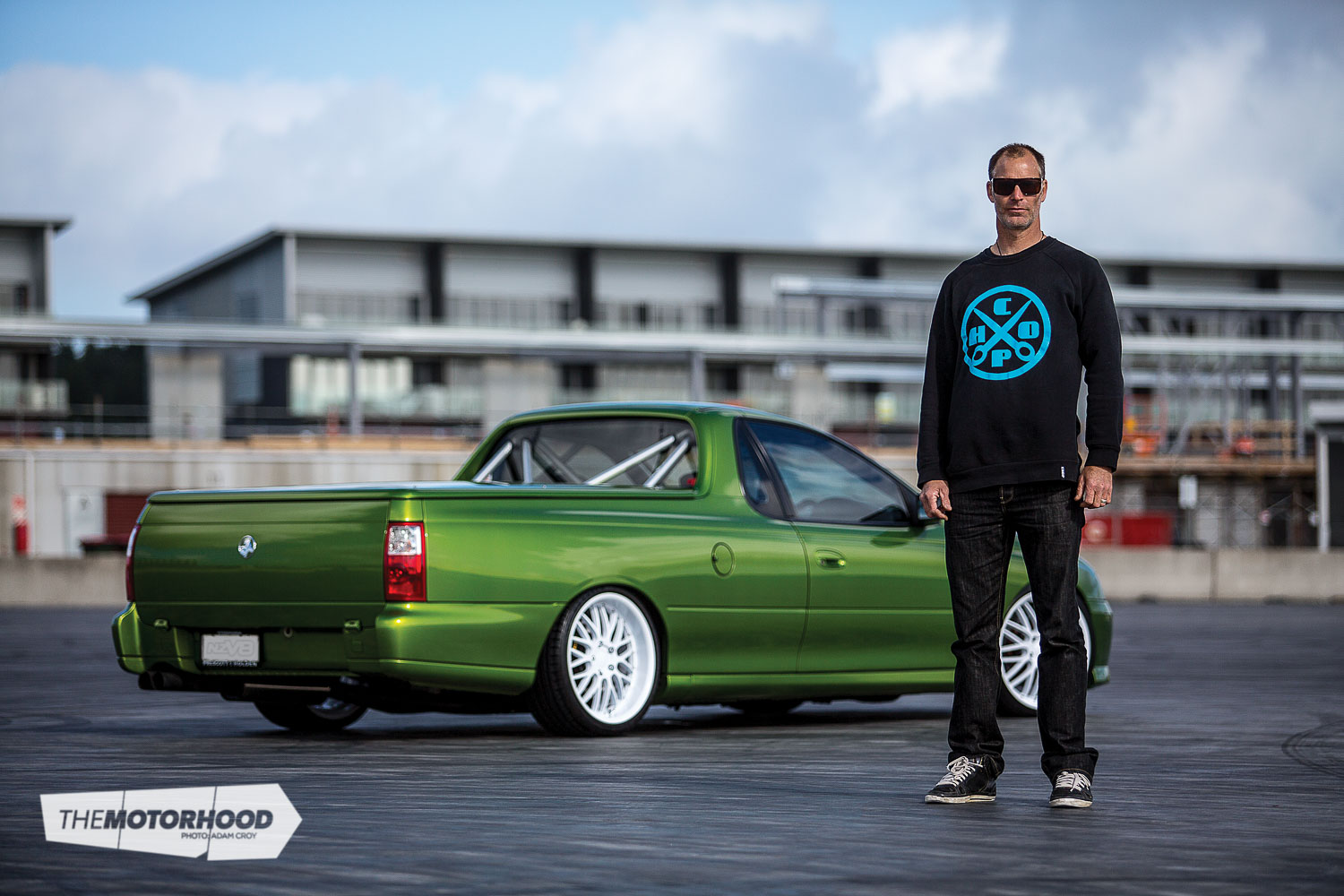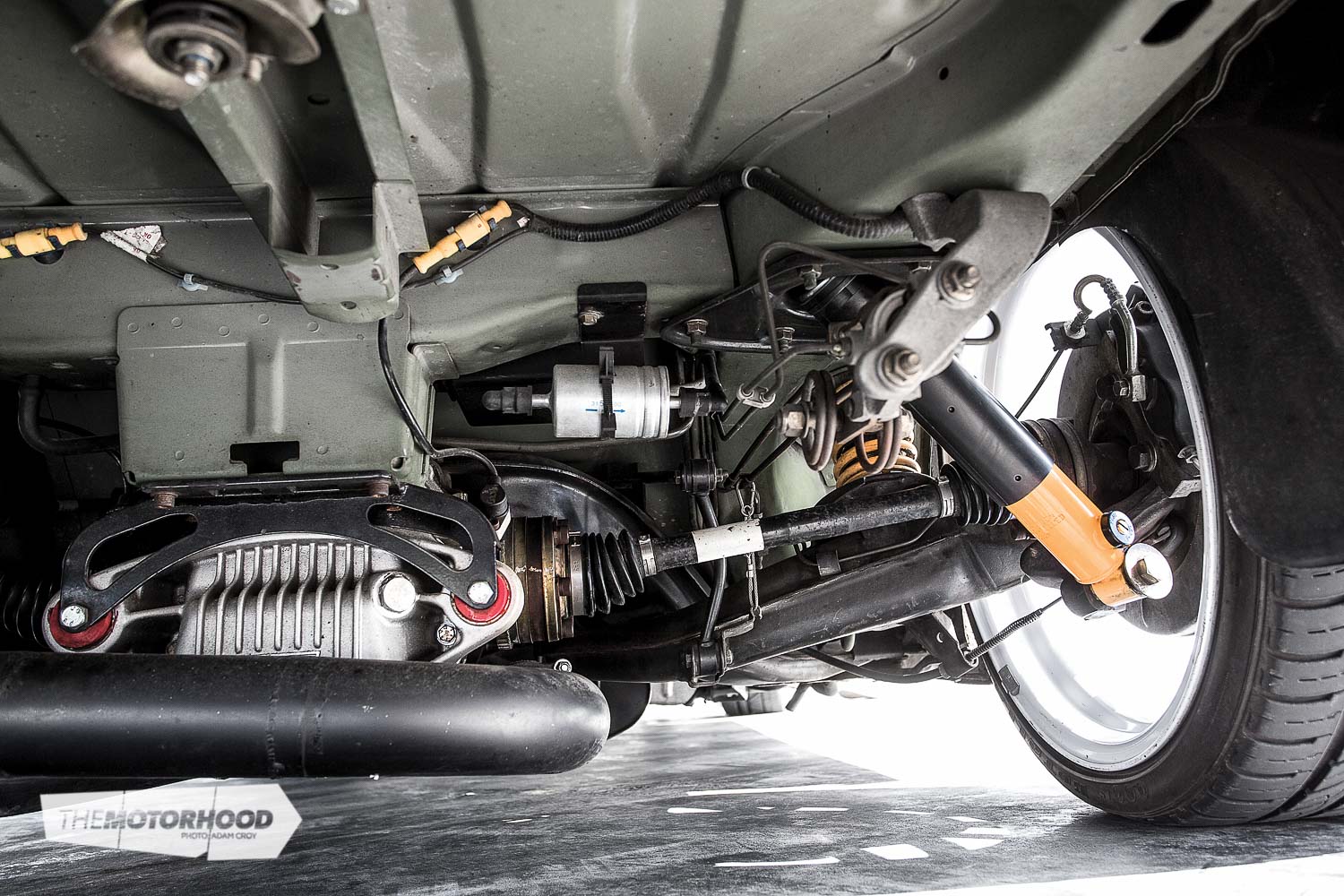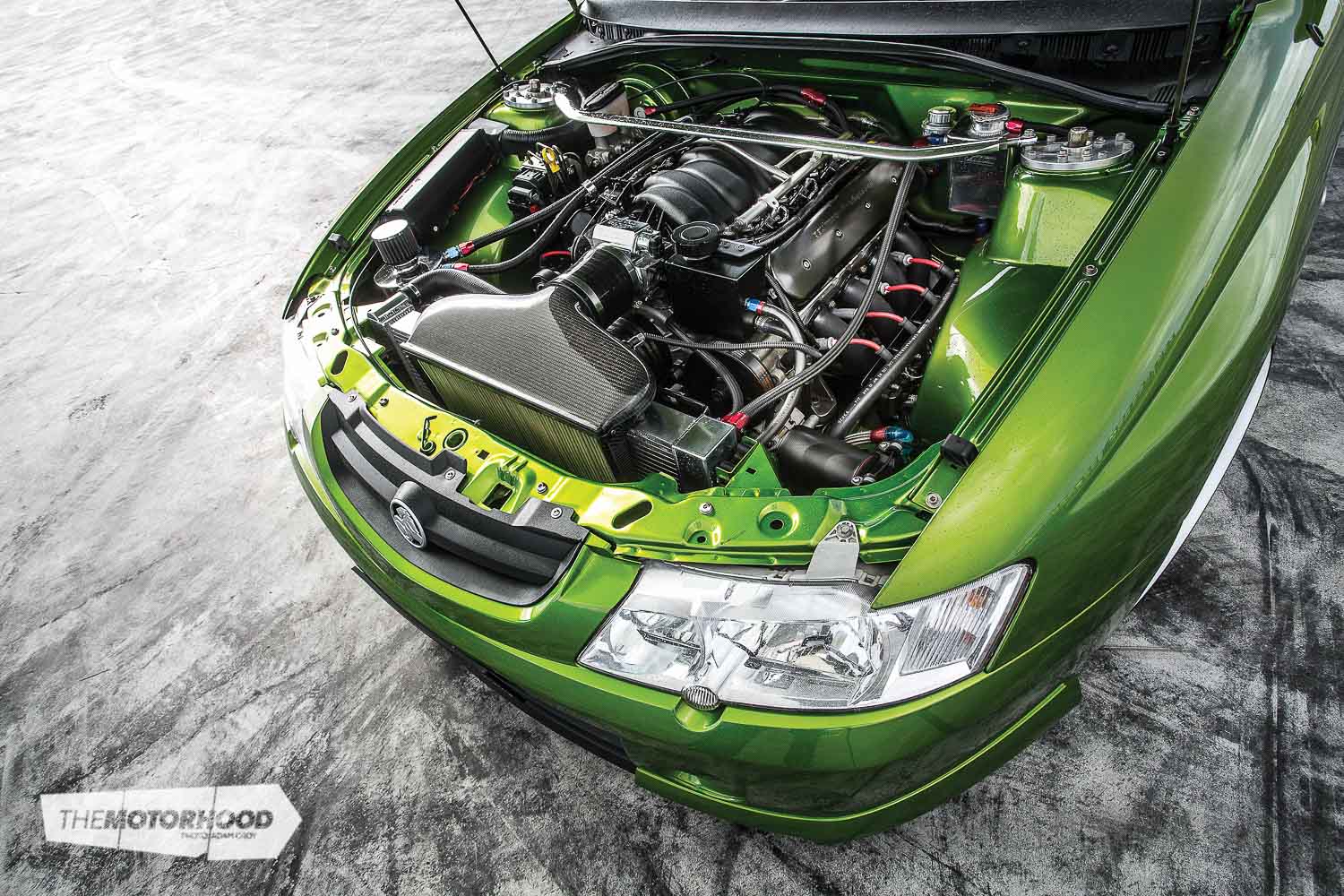
data-animation-override>
“It’s not every day you hear of a work hack being transformed into a screaming circuit-carver — but for Max Gillespie that’s a 500hp reality”
When you work in the construction industry, finding the right work vehicle is important. It needs to be able to carry all your tools and equipment — a heavy load-rating helps — and fuel economy is definitely not going to go amiss. So, with that in mind, we’re not entirely sure how Max Gillespie ended up with an LS1-powered Commodore ute as his work hack, but that hardly matters when you see what 10 years of ownership has turned it into.

In 2005, Max purchased the ute, completely bone stock, for work duties. The Commodore did well, but it only took a year for him to discover the LS1-tuning scene, after which nothing would ever be quite the same again. A disappointing experience with the first crowd he took the ute to led him to the highly regarded team at Eastern Automotive Performance Centre (EAPC), in pursuit of power. Heads were sourced from Scoggin-Dickey Parts Center in the US, and the addition of an aftermarket camshaft, a 90mm billet throttle body, an alloy intake manifold, Genie headers, and an upgraded exhaust pushed the LS1’s output to well over 400hp at the rear wheels. Max was understandably blown away by the increases in power and torque, as well as the incredibly angry sound from beneath the bonnet, but, quite sensibly, decided to retire the ute from work duties. Feeling the need to use the extra power a bit more sensibly, Max gave drag racing a go, managing a very respectable 12.6-second quarter-mile. However, it wouldn’t be long before the next set of upgrades was due to take place. A drag racing mate suggested joining the Commodore Car Club and taking the ute to a track day at Pukekohe Park Raceway. “From that first track day, my passion for circuit racing was born,” Max recalls. “I loved the adrenalin rush of high speed cornering, and the concentration it required.”

Of course, the limits of the Commodore’s factory underpinnings soon became apparent. It was dragged back into the workshop for the modifications to continue — an Exedy twin-plate clutch, a Harrop short-shifter, and 3.9:1 diff gears sorted the driveline, but effective power delivery is only one ingredient in the recipe for a successful track car. To sort the handling package, Bilstein coilovers were installed up front, complemented with Koni adjustable rears, Nolathane bushes, and a beefy 30mm front sway bar. Huge AP Racing brakes found their way to each corner, and the semi-slick tyres Max uses for track duties ensure that power delivery, cornering, and stopping are all dealt with as efficiently as possible. A pair of Racetech 1000 fixed-back bucket seats were also installed — necessary to allow Max to make full use of the Commodore’s dramatically enhanced handling capabilities.

Such enhancements immediately paid dividends, and, with tuition from Paul Manuell about lines and braking points, Max managed to cut his lap times around the old Pukekohe track layout down to 1min 6s. Max was pushing pretty hard but always stuck to his number-one rule — keep it off the wall! Such rapid lap times drew Max to make another decision, in the name of safety — the Commodore was going to need a roll cage. Expert fabricator Kerry Holland, at Top Gear Autotech, was contacted for this stage of the build. Max wanted a full eight-point roll cage, and that would mean having bars going through the rear window — despite Max having been told by a number of people not to do this, Kerry had no concerns about doing it. While he was at it, Kerry cut out the factory strut tops and welded in a set of adjustable camber plates, giving a degree of flexibility between street and track suspension set-ups.
“I remember going down to Kerry’s workshop to check progress, and seeing the ute stripped with a cage being welded in — I just thought, What the f@#k am I doing?!” Max laughs.
With each lot of work being performed on the ute, it was beginning to look more and more like a full-on race car. However, when it came to the interior, Max was determined for it to be nice, tidy, and — most importantly — subtle.

His good mate Phil Otene is a panel beater by trade and gave Max a hand to sand and prep the stripped interior for painting. The Holden catalogue was raided for paint codes, and Phil sprayed the cage in Quicksilver and the rest of the interior in Hothouse Green. In pursuit of tidiness, the dashboard was reinstalled around the roll cage, and Max made up carbon-fibre panels to house the toggle switches, oil-pressure warning light, and Auto Meter gauges in the now-empty stereo slot. However, the roll cage also rendered the factory door cards unusable, so Max was left scratching his head at how he’d tidy the doors up. Luckily, Paul Manuell came to the rescue, sourcing a pair of genuine V8 Supercars carbon-fibre door cards. “They were perfect, but a real stress and mission to fit. The interior is still one of my favourite aspects of the car,” Max says. Once again ready to hit the track, Max had a lot of fun over the next year, taking the ute to Powercruise and track days and doing a bit of street driving. By this stage, though, the LS1 had taken a fair beating and was getting a little tired — plus, Max was beginning to feel the urge for more power.

As if by chance, Max learned that Paul Manuell was looking to sell the LS7 from his V8 SuperTourer after the end of the race season. Max began doing his homework, comparing costs and power figures for the LS7 versus rebuilding and stroking the LS1 — as it turned out, the LS7 was a no-brainer. The biggest hurdle he’d need to overcome would be converting the LS7 to a wet-sump oiling system, to clear the Commodore subframe; a kit from Scoggin-Dickey Parts Center would take care of that. With this info in mind, Max decided to commit to the LS7 and paid a deposit for the engine — now began the nerve-racking wait, watching the V8 SuperTourers on TV and hoping the engine would still be in one piece by the end of it.
You can guess what happened. A short while later, Paul got in touch with Max, informing him that the

LS7 had broken a valve-spring retainer, causing a bit of damage, and the engine would be subject to a full rebuild. The completely blueprinted rebuild included new rods and pistons, as well as line-bored cylinder bores and crankshaft mains. With that in mind, and the fact that the engine would be built by Royce McCort at Autospeed Engineering — the builder of Greg Murphy’s former V8 Supercars engine — Max once again committed to the LS7 and began gathering the parts and information he’d require to transplant the LS7 into the Commodore.
Having the LS1 out of the engine bay allowed Max to tidy up what is typically the messiest area of any late-model car. Max again called on Kerry, who came out and seam-welded the chassis, strut towers, and wheel wells, as well as filling the holes that were left from the removal of the heater and air conditioning. This work was finished off with Max’s garage temporarily becoming a spray booth, so Phil could apply fresh coats of Hothouse Green to the improved engine bay.

With the LS7 ready to go and a set of HPC-coated Di Filippo four-into-one headers yearning to make some noise, Max wasted no time in slotting the LS7 into the freshly detailed engine bay. Dion at Howick Auto Electrical was then tasked with sorting out the wiring side of things, including deleting and hiding as much of the wiring as possible. The result is amazing; the engine bay looks unbelievably clean for a late-model car. Unfortunately, around this time, Max broke his neck in a surfing accident, and the Commodore was forced to sit idle for six months while he recovered. With a lot of time off work during his convalescence, Max was soon back into it, polishing off all the little jobs needed to get the ute running.

The installation of a Fast 102mm billet throttle body, Xair over-the-radiator cold-air intake, and Di Filippo 3½-inch stainless exhaust rendered the Commodore ready to hit the EAPC dyno. While Max was understandably nervous about the dyno tune, he needn’t have worried. The LS7 pumped out an incredible 400kW (536hp) at the rear wheels — close to 700hp at the flywheel — screaming to 6500rpm on each power run with ease, and easily wheelspinning on the dyno. Max’s first road test on the way home confirmed this, with the Commodore easily breaking traction in the first three gears.
Since then, Max has had the ute out at Pukekohe Park Raceway a few times, with the LS7’s torque putting him to the test a couple of times. He’s also had the ute out on Hampton Downs, at events such as Powercruise and the Mothers Chrome Expression Session, where he won a trophy in the competition class.
“These events are a lot of fun, being able to smoke the tyres at just a stab of the throttle. But most of the time, it flies under the radar — at a glance, it just looks like a ute with a set of rims, although it tends to pull a crowd if I leave the doors open and the bonnet up,” says Max.
Surprisingly, future plans are pretty minor. All Max would really like to do is a bit more suspension work, to improve the geometry and gain adjustability. Other than that, he’s looking forward to enjoying the car however he can — and the fact that it has remained road legal means that he really can enjoy it whenever he wants. So, if you’re ever on the road and catch sight of a green Commodore ute carving up the street, don’t blink, as you might just miss it.
003 Holden Commodore
- Engine: 427ci GM LS7, LS7 cast alloy block, pressed-in cylinder sleeves, six-bolt mains, forged steel main bearing caps, forged steel crankshaft, 4.125-inch stroke, forged titanium rods, alloy flat-top pistons, 11:1 compression, EAPC custom hydraulic roller camshaft, LS7 alloy heads, CNC-ported, 70cc chambers, 1.8:1 rockers, 56mm titanium intake valves, 41mm sodium-filled exhaust valves, LS7 intake manifold, Fast 102mm billet throttle body, Xair carbon-fibre over-the-radiator intake, Di Filippo four-into-one stainless headers, HPC coated, Di Filippo twin three-inch stainless exhaust, high-volume in-tank fuel pump, factory fuel lines, factory injectors, LS1 ignition coils, MSD ignition leads, factory ECU, double-row timing chain, LS3 timing cover, crank spacer, LS1 oil pick-up, windage tray, Commodore VZ sump, Improved Racing baffle kit, high-volume oil pump, remote oil filter, stainless breather tank, stainless coil-mounting brackets, alloy radiator header tank
- Driveline: Tremec T56 six-speed manual, rebuilt internals, Harrop short shifter, Direct Clutch twin-plate clutch, factory diff housing, Harrop diff cover, 3.9:1 final drive ratio
- Suspension: Bilstein coilovers, King Springs race springs, adjustable front camber plates, factory independent rear suspension, Koni adjustable shocks, King Springs race springs, 30mm front sway bar, Nolathane bushes, strut brace
- Brakes: AP Racing six-piston front calipers, 365mm AP Racing two-piece front rotors, AP Racing four-piston rear calipers, AP Racing 330mm rear rotors, braided brake lines, factory ABS
- Wheels/Tyres: 19×8.5-inch and 19×9.5-inch DTM wheels, 245/35R19 and 275/35R19 Nitto Invo tyres
- Exterior: Custom Lexan rear windscreen, modified rear hard cover, factory Hothouse Green paint, roll cage painted factory Quicksilver
- Chassis: Seam-welded chassis
- Interior: Sparco steering wheel, billet shifter, Auto Meter mechanical gauges, Gizzmo shift light, Racetech 1000 fixed-back bucket seats, Sabelt harnesses, eight-point roll cage, V8 Supercar carbon-fibre door cards, carbon-fibre centre console panels
- Performance: 536hp (at the wheels), 1min 06s at Pukekohe, old track layout, LS1
Driver profile
- Driver: Max Gillespie
- Car club: Commodore Car Club
- Age: 40
- Occupation: Building company director
- Previously owned cars: Nothing interesting
- Dream car: Probably a SuperTourer-like race car, or a big-horsepower Pro-Tourer
- Why the Commodore? To cater for my passion for circuit racing
- Build time: Seven years
- Length of ownership: 10 years
- Max thanks: Mike, Paul, Shaun, and Mark from Eastern Automotive Performance Centre; Kerry Holland from Top Gear Autotech; Phil Otene; the guys who did the Lexan — sorry, I can’t recall their names; MMM Racing; Dion from Howick Auto Electrical; Adam from XAir
This article was originally published in NZV8 Issue No. 127. You can pick up a print copy or a digital copy of the magazine below:













